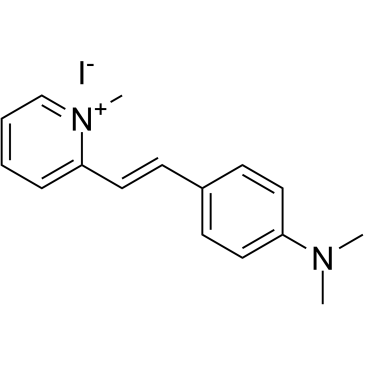2-Di-1-ASP |
| カタログ番号GC38730 |
2-Di-1-ASP (化合物 18a) はモノストリリル色素であり、ミトコンドリア染色および二本鎖 DNA の溝結合蛍光プローブとして広く使用されています。
Products are for research use only. Not for human use. We do not sell to patients.

Cas No.: 2156-29-8
Sample solution is provided at 25 µL, 10mM.
2-Di-1-ASP (Compound 18a) is a mono-stryryl dye, and widely used as mitochondrial stain and groove-binding fluorescent probes for double-stranded DNA. 2-Di-1-ASP is selective for G-quadruplex (G4) and double-stranded DNA[1].
2-Di-1-ASP (Compound 18a) displays significant fluorescence enhancements in the presence of G-quadruplex (G4) structures (up to 300-fold), and good selectivity with respect to double-stranded DNA. 2-Di-1-ASP shows fluorimetric selectivity for parallel G4-DNA forms (c-kit2, c-kit87up, c-myc)[1].
[1]. Xie X, et al. Identification of optimal fluorescent probes for G-quadruplex nucleic acids through systematic exploration of mono- and distyryl dye libraries. Beilstein J Org Chem. 2019 Aug 6;15:1872-1889.
Average Rating: 5 (Based on Reviews and 21 reference(s) in Google Scholar.)
GLPBIO products are for RESEARCH USE ONLY. Please make sure your review or question is research based.
Required fields are marked with *




















